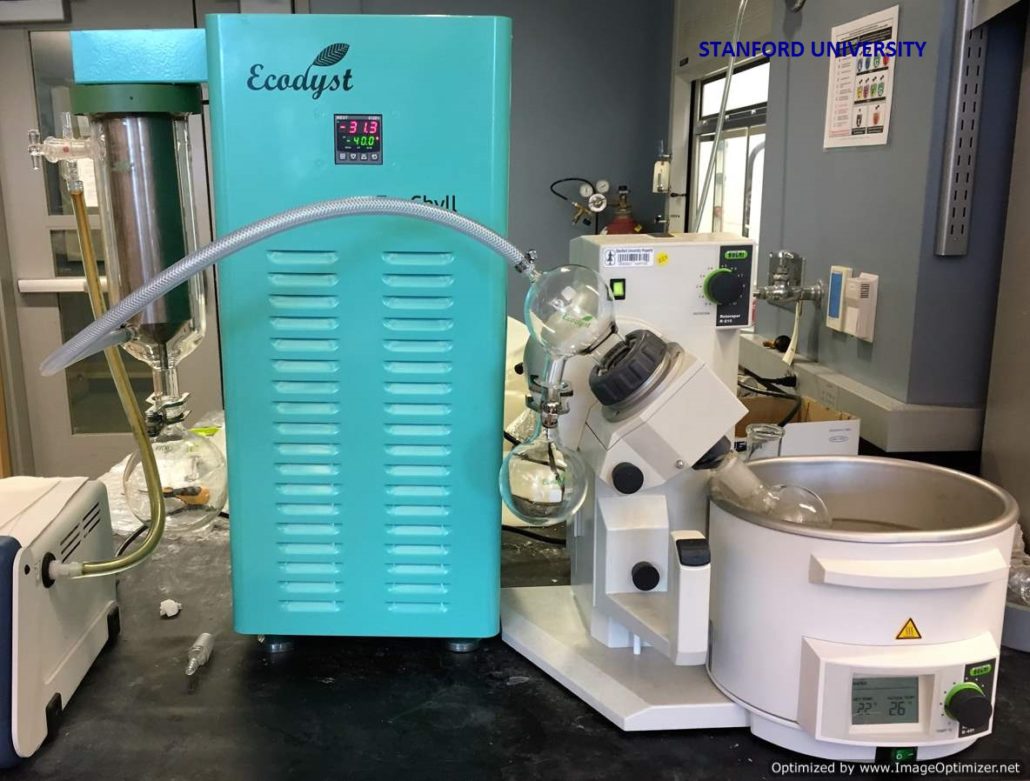Source: ecodyst.com
Published: July 16, 2016

Problem:
Rotary evaporators (“rotavaps”) have for decades been staples in labs and industries performing chemistry, including labs in the chemical, environmental, materials, life science, and forensics industries. Key applications include sample concentration, solvent recycling, extractions, and separation of solvent mixtures. Rotavaps consist of a heating fluid bath, rotating motor, evaporating flask, condenser, collection flask, and vacuum source. Solvent distills from the sample under the combined effects of heat and vacuum, and collects in the collection flask after condensation by the condenser.1
The condenser is either equipped with a coil through which coolant (water) passes, or a “cold finger” charged with dry ice or liquid nitrogen. In the past decade recirculating chillers have emerged as an alternative to tap water due to customers’ desire to conserve water and save on water bills. However, traditional recirculating chillers can be bulky (big footprint), heavy, complex, and inefficient, which limit their widespread use. High-efficiency condensing of low-boiling solvents is still achieved with dry ice.
The limitations of recirculating chillers have created four traditional methods of cooling condensers in use today. Namely: tap water, recirculating chiller (water and/or anti-freeze), and dry ice. Using dry ice requires researchers to continually fetch and fill the condenser with dry ice and constantly monitor dry ice levels. Anytime dry ice is not available, productivity is negatively impacted and routine exposure to dry ice also presents health concerns such as frostbite and exposure to carbon dioxide. It is not convenient to use dry ice on a daily basis. Furthermore, in many laboratories, the evaporation of solvents takes up a lot of time that scientists would prefer to spend on more complex tasks.2
Solution:
What is needed is an efficient condenser cooling system that addresses the problems associated with traditional methods of cooling condensers. A desirable high-efficiency condenser cooling system is much needed in the industry. It would be advantageous to reduce size, weight, complexity, and improve cooling temperature and functions of the condenser cooling system. Researchers have been waiting for a condenser that is always available and has a wide range of cooling temperatures. Additionally, any technology that will relieve rotavap users of the routine condenser cooling challenges will free them to focus on more complex tasks. Rotavap users should not be burdened with condenser cooling issues.
Ecodyst has met this existing technological gap with its innovative EcoChyll instrument. The instrument was designed with the entire spectrum of rotavap users in mind and it incorporates customer-desired features. EcoChyll is a condenser cooling system that upgrades any existing rotavap.
The system increases productivity and eliminates downtime and its refrigerated cooling condenser sets a new standard for cooling down samples or processes without the use of traditional coolants such as water or dry ice. EcoChyll is “tankless” and does not require water and/or antifreeze coolant. Its cooling temperature can reach -20°C in less than one minute and attain cooling temperatures superior to dry ice. EcoChyll’s cooling technology is continuously available, easy to use, saves time, and is worry-free. This is the way evaporation should be—the user shouldn’t be concerned with condenser cooling issues.
A system such as this rapidly condenses vapors from samples or solvents and thereby reduces evaporation time and increases productivity. EcoChyll provides desired cooling, faster evaporation, environmentally friendly operation, a reduced footprint, and a wide range of cooling temperatures. High-efficiency trapping of low-boiling solvents is easily achieved. Upgrading any rotary evaporator with a system like this can save money and time, increasing productivity.
For more information, contact George Adjabeng, Ecodyst Inc. at 919- 599-4963, info@ecodyst.com, or visit www.ecodyst.com.
